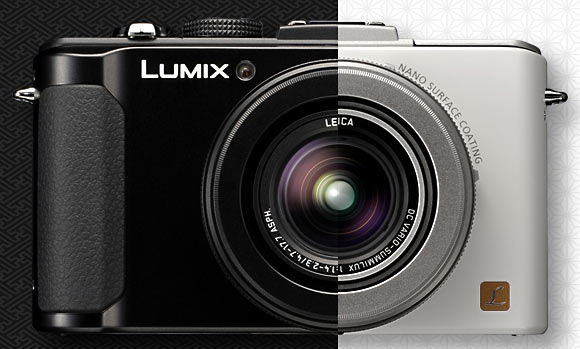Review Date: November 23, 2012
Category: Serious Amateur


Photoxels Gold Award – Premium Compact Camera
USER’S EXPERIENCE
Wednesday, November 7, 2012 – Here’s what I receive in the box:
- Lumix DMC-LX7 [black]
- Lens Cap and retaining String
- No memory card
- Li-ion Battery DMW-BCJ13PP 3.6V 1250mAh 4.5Wh
- Battery Charger DE-A81
- Hot Shoe Cover
- Shoulder Strap
- USB Cable
- Manuals: Basic Owner’s Manual (printed), Owner’s Manual for advanced features (CD)
- Software CDs: PHOTOfunSTUDIO 8.3 PE (Win only), SILKYPIX Developer Studio 3.1 SE (Win & Mac)
Bright F1.4 Lens. The Panasonic LX7 is an intelligently designed premium compact camera with a bright F1.4 lens. It does not look clunky like some of its competitors, but sleek and professional. You can get it in either black or white — though a B&W version, as pictured above, might have also been interesting.
The bright F1.4 lens is what would attract most enthusiast photographers. A large aperture allows more light in and therefore the use of a faster shutter speed — hence, less camera shake. It theoretically allows out of focus backgrounds though, in practice, don’t count too much on that. More light in also means a better low light camera.
Set it to iA for fully automatic shooting or switch to one of the PASM modes to take over full control.
It has a very desirable Aperture Ring, which I absolutely love! However, there is no corresponding Shutter Speed Dial, and I found that sort of disconcerting. In fact, I found myself switching the Mode Dial to A and then pressing the Rear Dial button to switch it from setting the shutter speed to setting the aperture — as is the functionality in most other cameras with no Aperture Ring. Nothing happened. Then it dawned on me that there is an Aperture Ring. Duh!
To compound matter more, the range of available apertures depends on the focal length (so at full tele, the max. aperture is F2.3 and rotating the aperture ring to F1.4 is meaningless) and the Aperture Ring is, of course, usable only in S and M modes.
The presence of an Aperture Ring and the lack of a Shutter Speed Dial prove somewhat confusing to this photographer. I believe an Aperture Ring should always be accompanied by a Shutter Speed Dial.
HINT: You can display an exposure meter on screen that indicates the range of shutter speed and aperture for a correctly exposed photo. Turn it on or off depending on whether you need that help or, like me, find it takes just a bit too much of my screen real estate. [MENU – Setup 4 – Expo.Meter – ON/OFF]
The Rear Dial is too easily clicked. For example in P mode, you rotate it to program shift. However, it is easy to click the Rear Dial while you are rotating it and you end up dialing an Exposure Compensation instead.
When shooting a movie, you can zoom silently and continuous focus takes about 1 sec. to refocus. You can take still pictures during movie recording and they will not interrupt your movie. Still pictures are recorded at 3.5M.
In Manual Focus, the screen display can be enlarged 5x, 10x or 4x for precise focusing. First rock the ND/Focus Lever to enlarge the display to 5x, then click the ND/Focus Lever repeatedly to toggle through the 3 options.
HINT: In Playback, the LX7 will allow you to view an enlarged display from photo to photo using the Rear Dial. This is especially useful when reviewing a series of pictures you’ve taken of the same subject. You get to view the same enlarged portion of each picture as you browse so as to select the one that is sharpest.
The LX7 is fast: it turns on in less than 2 sec. and you can shoot one picture after another as fast as you can press the shutter and for as many shots as you want. I stopped after shooting 83 photos in 1 minute (in P mode, 1/100 sec., F1.4, with AF). Amazing! If you want Burst, the LX7 will shoot at 5.5fps (10M, using the mechanical shutter and with AF on each picture), 11fps (10M, using the mechanical shutter and with AF on first picture only), 40fps (5M, using the electronic shutter and with AF on first picture only), 60fps (2.5M, using the electronic shutter and with AF on first picture only), Flash (5 flash pictures at 3M, using the mechanical shutter and with AF on first picture only). The LCD display refreshes fast so you can more or less track your subject as the camera records the burst.
PHOTOfunSTUDIO 8.3 is a basic image viewer and editing software that seems to have been written back in the 80s. Perhaps, it is time for Panasonic to upgrade to a better image viewing and editing software? The Owner’s Manual for advanced features is on a CD, is well written, illustrated and indexed.
What I like about the LX7:
- A really enjoyable camera with user-friendly and intuitive controls.
- Very good image quality with low noise up to ISO 800.
- Bright F1.4 lens.
- Very good handling and feel.
- Fast and precise AF, even in low light.
- Love the aperture ring (when I remember it’s there).
No review is complete without a couple of improvement suggestions:
- Shutter Speed Dial
- A tiltable LCD
- Touch AF
- Built-in lens cover
- Bigger handgrip
The Panasonic Lumix DMC-LX7 is feature-packed and the image quality does not disappoint. It’s the digital camera I reached for everytime I went out, preferring to leave the more bulky and heavier cameras on the shelf. Highly Recommended.
Next: Panasonic LX7 QuickFact Sheet / Buy


















